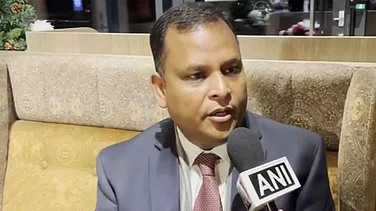
RBI likely to pause rate cuts in August amid new US tariff uncertainty.
100 bps in cuts already frontloaded since February, with more data awaited.
Economists split—some see October as next cut window, others urge August action.
Persistent inflation moderation and slowing growth keep rate cut debate alive.
The Reserve Bank of India (RBI) Monetary Policy Committee (MPC) began its three-day meeting on Monday. Governor Sanjay Malhotra is set to announce the outcome of the policy review on 6 August at 10 a.m.
Last month, Malhotra signalled that further adjustments to the policy rate were not off the table, depending on how the data unfolds. So far, the central bank has delivered a cumulative rate cut of 100 basis points (bps) since February this year. Prior to that, the MPC had held the repo rate steady across 11 consecutive meetings, citing elevated inflation.
With inflation having eased significantly in recent months, many economists had earlier flagged August as a potential window for another rate cut. ICICI Bank, for instance, noted that while the inflation outlook remains benign for now, headline inflation could rise in the final quarter of FY26 and into FY27 due to base effects—potentially limiting the MPC’s room to cut rates later in the year.
External Headwinds Loom
However, fresh external shocks appear to have complicated the picture. The recent decision by the United States to impose a 25% tariff on all Indian exports, effective 7 August, has added a layer of geopolitical and trade-related uncertainty to the RBI’s deliberations. The tariffs were announced after both countries failed to finalise an interim trade deal ahead of President Donald Trump’s self-imposed 1 August deadline. Trump also threatened India with an unspecified "penalty" over its defence and energy ties with Russia.
It is widely expected by the markets that the US tariffs will come down. However, economists warn that if they persist, they could shave 20–40 bps off India’s GDP growth in FY26.
"External factors such as recent US tariff hikes and rupee volatility further add to the uncertainty. With these risks in play, the RBI is expected to adopt a “wait and watch” approach, refraining from additional easing until there is more clarity," said Bajaj Broking.
It also expects that, having already frontloaded rate cuts and ensured adequate liquidity, the MPC is likely to pause and allow time for the effects of previous measures to filter through the economy. "Any further rate action—if deemed necessary—is anticipated only in October or beyond, once more data on festive demand, agricultural output, and global conditions is available," Bajaj Broking added.
Echoing the same sentiment, CareEdge Ratings also does not expect the RBI to announce any rate cut in the August policy, especially as the real policy rate—adjusted for inflation—is likely to settle from 1-1.5% at the current repo rate.
Pause Now, Cut Later?
Gaura Sen Gupta, chief economist at IDFC First Bank, expects a status quo in August after the frontloading of 50 bps rate cut in June. She says that a rate cut is more likely in October.
“After front-loading a 50bp-rate cut and shifting to a ‘neutral’ stance at the last policy, we see MPC holding rates steady at 5.5%,” Nuvama said. It also noted that Governor Malhotra had earlier hinted at limited room for further easing. However, the brokerage firm believed the case for additional rate cuts is “compelling”.
Separately, three surveys conducted by Reuters, Business Standard, and The Economic Times also point to the MPC maintaining the status quo this month, largely due to the uncertainties stemming from the US.
Yet, Rate Cut Calls Persist
Calls for further easing have not entirely died down. Meanwhile, the group chief economic advisor at the State Bank of India, Soumya Kanti Ghosh, argues that another frontloaded cut in August could act as a timely boost ahead of the festive season. "No point in committing a Type 2 error today by not cutting rates in August, as inflation will continue to remain rangebound even in FY27," said Ghosh—who had correctly anticipated the outsized 50-bps cut in June.
A Type 2 error occurs when the central bank fails to reject the null hypothesis, assuming that the inflation undershoot is temporary, and hence does not cut rates—but in reality, inflation remains persistently low and the output gap continues to weaken.
Ghosh also added that monetary policy operates with lags and postponing a rate cut until inflation falls further or growth weakens more visibly could result in deeper and more persistent economic damage.
Dhiraj Nim, economist at ANZ Bank, also revised his forecast and now expects a 25bps rate cut, advancing his earlier October forecast. "Q2 growth indicators slowed across the board. US tariff hikes add downside risk to exports, reinforcing a dovish bias for monetary policy. Trade uncertainty currently is not a two-sided risk. However, the RBI may not revise its growth forecast yet," said Nim.

































